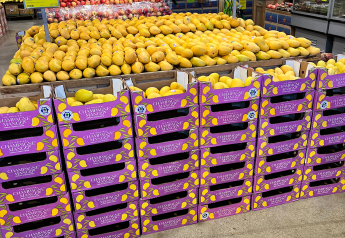Another wild ride for trucking rates

For produce shippers and truck carriers, 2021 is one for the record books.
The Packer spoke on May 25 with Dean Croke, Boston-based principal analyst for DAT Solutions, about the unprecedented truck rate increases the industry has seen far, and what may be around the corner.
Readers can click here to download Croke’s weekly blog post about truck rates.
The Packer: Dean, what is your role at DAT?
Croke: Essentially what my role is, as a market analyst, is to really understand the supply and demand side of the business, to help explain the directionality of the freight rates and the spot rates. I’m doing some analysis on new truck orders, new trailer orders, the driver shortage, what’s going on with drivers, training schools, talking about some of the broader macro issues, and then diving into specific rate trends in those markets.
That research I do goes off in a bunch of different directions. It’s really about explaining why rates are the way they are, and then we run forecast models to give people a feel for where we think they might be. In our industry, produce, it’s what will happen after July 4 when normally peak. We were running our forecast out past (July 4). And of course, this is one of those crazy years where there is a really good sense that this could go on a lot longer than July 4 because it’s a supply-driven market, not demand driven. Because you can’t find trucks, and then you can’t find drivers to sit in the trucks.
The Packer: Talk about truck lanes and destinations a little. Trucks can be tight, but not all lanes are performing in the same way, right?

Croke: Yes. The pandemic disrupted a lot of commodities. One of the trends that we’ve seen is that packaging types have changed. You know, a pound of avocado in (bulk) is very different than it is within little, tiny plastic packages half-filled with air. (With packaging), you get this expansion of freight that goes into trucks. And then you’ve got the channel shift; you’ve got people buying more online and less at the store. So, you have got less volume moving from Nogales to Hunts Point in New York, and (instead) it’s going from Nogales to a distribution center somewhere else.
So, what that has caused is for carriers that would have undertaken their annual bid with their shipper where they agreed to provide freight at certain rates on a certain A to B origin and destinations. Suddenly they get this load that’s Nogales to Harrisburg instead of Hunts Point, and then they have to factor in all these deadhead miles out of Harrisburg to where they would normally load. That balance has been thrown out, because of the changes in where loads have been sent this year, because we’ve had a lot of new destinations because of all the warehouses that are thrown off (normal business). So, what it’s meant is that the big truckload carriers have said, if we don’t have a rate in our system (for alternate destinations) on the contract side, we will reject it, and then it goes to the spot market. And of course, the shippers are left with a much higher rate to move that load to that destination.
If you’re a really big shipper, they’ll go to the market with essentially an Excel spreadsheet that says,’ We’ve got 10,000 loads this year, we’ve got x number a week to Chicago and x number to New York, what’s your best price?’ And a carrier will say, yes, that lane fits us for that direction, because I’ve got all this freight back the other direction, so I’m going to be $2.20 a mile and I’ll provide you with x trucks a week.
It’s not a written contract, but it’s a verbal agreement. What happens is, when this pandemic hit them, and shippers suddenly had hardly any volume on some lanes, because manufacturing was shut down or an area was gripped with a pandemic. Other areas were booming. And we’ve seen commodities in the produce sector do really well and others do really poorly. What’s happened is where a shipper might say, hey, I’ve got all these extra loads, I’ve got to move this week. And the contract carrier says, ‘But I only agreed to 500,’ so he rejects the other 100 on top of that, and they go to the spot market. And of course, in the current year, that’s about 20% of total volume for the spot market. If you’re moving 20% of your loads on the spot market, you can ruin your entire transportation budget for the year.
The Packer: Is that percentage of 20% for spot market business higher than normal?
Croke: Yes, it’s almost double what it’s normally been. The normal range is 12% to 15% of all freight will move on the spot market Normally, something like 85% to 90% would move on contracts. Normally in any pre-pandemic year, that’s a good guide. Now (the spot market) has been as much as 25%.
The Packer: Would you say that the refrigerated spot market is performing differently than the dry van freight rates during the pandemic?
Croke: Spot rates for reefer loads are at $2.77 (per mile) this week. Dry van spot rates are at $2.37. That’s not unusual for this time of the year, because normally the produce season starts to drive a lot of volume into the market. As the country gets warmer south to north, the produce season sort of goes as if it were five-year-old kids chasing a soccer ball. The carriers will just follow the produce around. You see all this imbalance in the reefer market because of the timing of crops. To answer your questions specifically about refrigerated truck rates, they are 89 cents a mile higher than this time last year.
Now, for context, remember the low point when truckers were protesting in Washington (last year) was the first of May. That was sort of the bottom. We saw a lot of bankruptcies happened in quarter two of last year. But by the time we got into quarter three and around the September mark, spot rates were starting to climb back up. At this junction right now, they are 89 cents a mile higher than a year ago. I think the other benchmark that I would use is 2018. Because remember how tight capacity was on the truckload side back then. Then we said 2018 is the tightest capacity in a decade. And freight rates were through the roof. Well, we’re already 54 cents a mile higher than that time.








